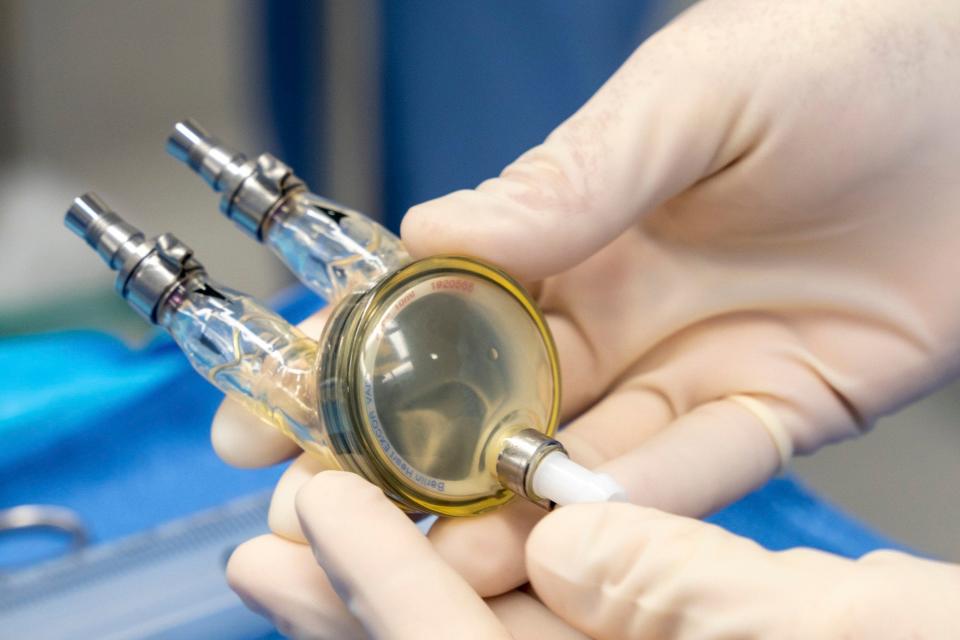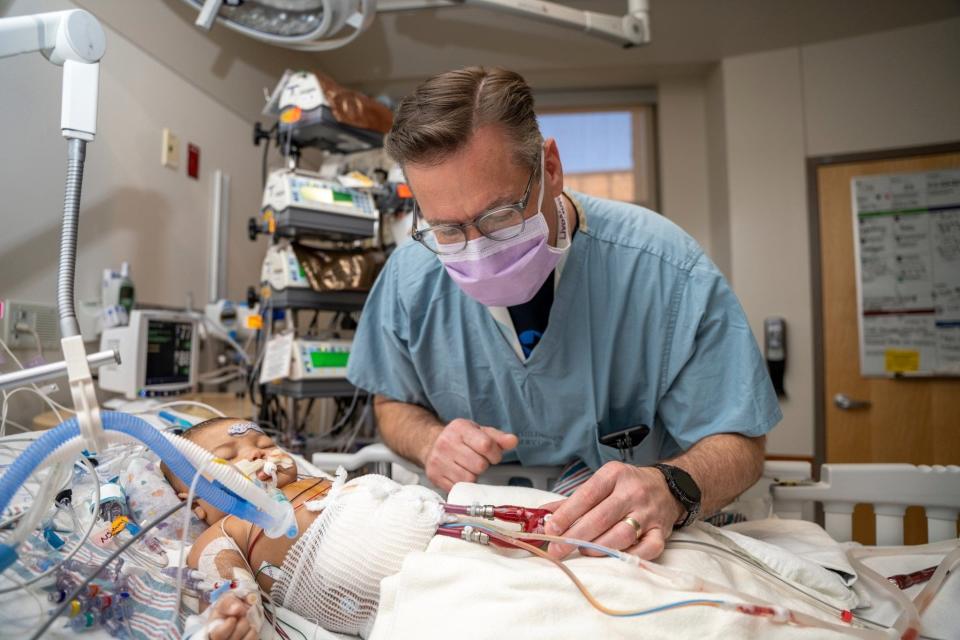A heart restored: Central Texas child makes amazing recovery after using mechanical heart
Koi'Anna Washington, 4, walked out of Dell Children's Medical Center in May to a cascade of bubbles from staff members who had taken care of her for more than five months.
That she walked out of the hospital at all was a miracle. That she walked out with her own healed heart seemed impossible.
"Koi'Anna is doing great!" said her mother, Cheryl Barrett. "She is literally going about life like she wasn't just fighting for it the last five months."
Koi'Anna survived for five months using a mechanical heart called the Berlin Heart Excor.
Hers is only the second documented case in which a patient was able to have the Berlin Heart Excor ventricular assist device removed without needing a heart transplant, said Dr. Charles Fraser Jr., head of the Texas Center for Pediatric and Congenital Heart Disease at Dell Children’s and UT Health Austin, the clinical practice of Dell Medical School at the University of Texas.
Koi'Anna's case will help doctors learn more about what could be possible in cardiac care and establish a protocol on how to wean children off a Berlin Heart and back onto their own heart.
The Berlin Heart was designed by the German company of the same name to be a life-sustaining bridge while kids await a heart transplant. Designed in the 1980s, it can be used only inside a hospital, which means kids with a Berlin Heart have to stay in the hospital until they receive a transplant.
Fraser came to Dell Medical School in 2018 to build the cardiac program, which implanted its first ventricular assist device in September 2019, did its first heart transplant in October 2020 and connected its first Berlin Heart device in February 2021.
Koi'Anna experienced the full capabilities of what the cardiac program at Dell Children's can do, but she also paved the way for the center to create a protocol for how to wean patients off a Berlin Heart and back onto their own healed heart.
Inside a growing program: In first year of heart transplants, Dell Children's finds niche in cases other hospitals pass on
Something is wrong
Koi'Anna is the kind of kid who wakes up before her parents, Barrett said.
"When she's up, she literally hits the ground running," Barrett said.
But on Dec. 3, Koi'Anna wasn't awake early. When her father, Quintin Washington, checked on her at their Central Texas home, Koi'Anna was panting hard, "like she had been running a marathon," Barrett said. She struggled to sit up and to look at her dad.
Washington called his stepmom, who is a nurse, and they tried to chart her heart rate. It was more than 200 beats per minute, but it was going so fast it was hard to track.
They rushed Koi-Anna to the emergency room at Dell Children's.
She was in heart failure, Fraser said. "She presented to us near death."
Koi'Anna had a very bad and unusual heart rhythm called junctional tachycardia, in which the electrical circuit in the middle of the heart is not firing properly.
"Her heart had ballooned up," Fraser said. "It was barely squeezing."
Barrett said Koi'Anna had been acting normally the day before, but the problem with her heart was something she was born with and had probably been getting progressively worse, Fraser said.
Doctors at Dell Children's did an ablation, which involves using either a laser or freezing to destroy the area that is misfiring, to prevent the electrical misfiring from continuing to happen, but Koi'Anna's heart had been too damaged to work on its own. They put in a temporary assist device to help her heart beat in the hopes that the organ would improve within days.
It did not.
The first Berlin Heart: 'You can see it beating': Baby gets another chance with 1st mechanical heart pump from Dell Children's
Moving onto a Berlin Heart
The doctors were then left with a dilemma. That device was meant to last only a week at most. If they left it in, they were risking bleeding, an infection, a stroke or death. If they took it out, they did not believe the heart had healed enough to function.
They would have to put in a Berlin Heart, which can last a year or more. It also meant that she would be listed for a heart transplant.
The Berlin Heart sits outside the body and is connected to the heart through two cannulas (tubes) that are sewn into the heart. One sends blood from the body to the pump. Another takes blood from the pump and puts it into the body.
The pump has a silicone bladder inside it. One side of the bladder is filled with air and the other side is filled with blood. In one phase, the bladder relaxes; in another phase, it fills with air. This creates the pulsating of blood in and out of the pump, moving it from the heart to the pump, through the pump and back to the heart. The pump is connected to a driver that pushes air in and out of the bottom of the pump.

"It's pretty gruesome," Fraser said. "It's a very crude device."
To insert the Berlin Heart, though, doctors have to open a hole in the bottom of a heart ventricle. It's not something they ever expect to have to repair, because that heart is not expected to need to function ever again without the device.
The Berlin Heart, which was inserted Dec. 13, did what it was supposed to do, Fraser said, but it did even better than they could have expected.
Koi'Anna's heart began to shrink to a more normal size. While Koi'Anna was in the hospital's cardiac intensive care unit, she looked like a normal girl playing, Fraser said, except that she had a Berlin heart outside of her body attached to the driver that is a rolling piece of medical equipment.

Doctors would do a periodic echocardiogram and see that her heart was actually getting better. That sometimes happens, but usually the Berlin Heart is still doing the work while the patient waits for the transplant.
Life after a Berlin Heart: Baby who received first mechanical heart pump at Dell Children's home after heart transplant
Not a permanent solution
The challenge with any assist device is clotting. Koi'Anna experienced that at the end of March. She had an ischemic attack from a clot that then resolved itself. It worried her team, though.
"The next time it could be a permanent stroke," Fraser said.
Doctors at Dell Children's began to talk about weaning her off the Berlin Heart to see if her own heart could take over.
"It's enormously rare and enormously controversial," Frasier said. "Recovering hearts like this and removing support is really in its earliest stages. We don't understand why some hearts move on from this and others don't. ... How do you know how much the heart has recovered?"
Fraser and the team reached out to colleagues around the world and looked at cases that had been written up about the Berlin Heart. They found only one other documented case in which the Berlin Heart was removed and the patient recovered without a heart transplant.
They would have to develop a protocol on how to wean Koi'Anna off the Berlin Heart to allow her own heart to do more of the work.
They did various tests during which they would turn the pump down and let her heart take over.
"She did so well on the weaning test," he said, they decided not to wait any more.
"We were afraid if we wait she could have a life-altering or even fatal complication," he said.
The weaning worked. Her heart took over.
"She never looked back. She got better and better," he said.
Then they had to figure out how to remove the device and repair the hole where it had been attached to the heart.
Her heart did well. She came off the ventilator within days.
"She didn't blink an eye," he said.
Paving a future for Koi'Anna and others
Koi'Anna is now considered inactive on the heart transplant list. Her medical team doesn't know what the trajectory of her heart will be because she's such an unusual case.
"We'll continue to fret about her and watch her," Fraser said.
Transplants have many drawbacks, including the antirejection drugs. Most heart transplants last about 15 years, though with younger kids they tend to last longer.
"Keeping her own heart is a very good thing," he said.
Koi'Anna's recovery would not have been possible without the cardiac center started here and the team that has come to Dell Children's.
"These are the kind of things that are possible in an enterprise where you have a leading children's hospital, a medical school and a high level of aspiration," Fraser said. "These are the kinds of things that have to evolve for Austin to be leading edge. This is definitely leading edge."
One of Fraser's dreams is for a new generation of heart devices to be tested here in Austin. He led the team at Texas Children's Hospital that got the Berlin Heart approved for use in pediatric cases by the U.S. Food and Drug Administration in 2011.
"This is really old technology," he said. "There's still nothing more we can offer in the United States as a bridge to transplant."
Koi'Anna's family is grateful to have her home.
"When we first got home, I did worry about her," Barrett said. "I worried about her overdoing herself and having a super high heart rate or putting stress on her heart, but all is well."
"I give God all the glory," Barrett said. "We prayed for full restoration of her heart, and he delivered."
This article originally appeared on Austin American-Statesman: Central Texas child's amazing recovery after using mechanical heart

